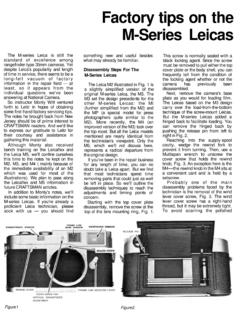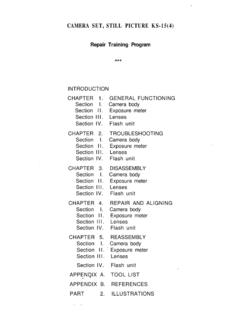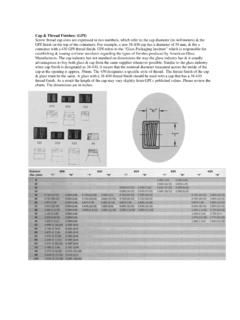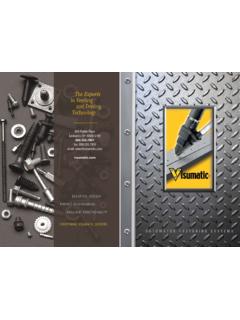Transcription of FED 2 (Фзд-2) - DIY Service & Cleaning - PENTAX MANUALS
1 FED 2 (Фзд-2) - DIY Service & Cleaning Adapted From the Rangefinder forums Article written by Laika The FED 2 is one of the most popular Soviet range finder cameras, and for good reason. However, you do hear people mention its small and dim'. viewfinder as one of its shortcomings. While we can't do much about the viewfinders design, we can make sure we are getting the best out of it with simple Cleaning and adjusting. To do a thorough job, the top cover need to come off - at this point those of us who are all thumbs are already backing away. Don't panic, the FED 2 is an easy camera to work on even if it's your first. I have done several, and the improvement in general view and RF contrast/clarity has been from good to dramatic. Also with the top cover components removed it's a great time to give everything a good clean (and most of them need it).
2 A friend of mine was horrified when he started scrubbing away at the winder knurling and realized that the dark brown muck coming out of it was what he now refers to as man fat'. It's worth remembering the FED 2 line started in 1955! Recommended tools and supplies: Tray ( Paper developing tray). Screwdriver set Needle nose pliers with padded jaws (heat shrink etc.). Lens spanner wrench (see comment). Q-tips, Window cleaner Toothbrush Strong soap or solvent for Cleaning chrome parts Matt black paint & small brush (optional). A couple of drops of oil or grease. Poster putty Comments: I always work on a camera in a tray, like an 8x10 paper developing tray or a kitty litter tray. When working with small parts you will drop them, and with one part lost your camera is out of action.
3 It's also handy if you're working on the kitchen table to be able to pick up the whole lot in the tray come dinnertime. The screwdrivers I used are a little set made by Stanley in a yellow box, I. find the sets you see a lot in the clear and blue plastic box are often poor quality and the tips snap off; try and get something a cut above the cheapest. I've put heat shrink on the jaws a set of long nose pliers for adjusting the RF cams and starting off a tight bezel without scratching or marring the finish. Buy a lens spanner wrench if you're going to work on a few cameras or lenses, mine was $15 from micro-tools (see link). A cheap DIY option is to file down the tips of an old set of long nose pliers to make a tool that will work, but take extra care not to slip and gouge the top cover!
4 This photo contrasts a rear view of an early and a late model FED 2. Some of the differences include the later style mushroom'. winder knob, with less knurling on both it and the rewind knob. The higher position of the accessory shoe on the later model is required when using a external viewfinder, unless the Soviet turret' finder can be found. The newer model uses a different shutter speed dial and is missing the two screws on the back of the top cover (replaced with a hidden screw under the winder knob (see later picture)). Also of note the earlier version has an extra engraving on the top cover. If you interested in the different FED 2 models check out Jim Blaziks great web page. Step 1. Shutter Speed Knob. Set a shutter speed (after cocking as always) and note it.
5 Unscrew both screws from the shutter speed dial and lift off the dial, partial winding of the shutter makes accessing the locking screw easier. Note; you don't have to remove the crews, just unscrew them a few turns. Step 2, Winder knob. Unscrew the locking screw in winder knob, unscrew winder knob anti- clockwise, and remove film counter dial and spring. Remove any spacer washers from the shaft. Note the order they come off in, I. have stuck them in some poster putty (Blu-Tack) but even a bit of sticky tape will make your life easy later. In this picture you can see the extra top cover screw in the late models that is hidden by the winder. Step 3, Shutter Collar. Unscrew the locking screw around shutter collar (put it into the rewind position if required to access the screw), screw off collar anti-clockwise.
6 Step 4, Accessory Shoe. Unscrew the three screws holding the accessory shoe. Step 5, Rewind Knob. Lift rewind knob and remove screw, then lift off the knob and collar. Note: the diopter arm is not removed at this point. From the inside (w/ back off). you can remove the rewind fork, spring and washer. Early FED 2's will have three small screws in the diopter arm; they can be removed along with the arm. Step 6, Eyepiece. Unscrew the eyepiece anti- clockwise, pliers with padded jaws might be needed just to get them started, but I tend only to resort to them after losing some skin off my fingers. Use care not to scratch or gouge anything! Step 7, Range Finder Cover. Unscrew RF cover anti-clockwise and remove. Now using the lens spanner, unscrew the RF lens anti-clockwise and remove.
7 Note that it is actually two pieces; the inner lens is rotated to correct the vertical alignment. After Cleaning I like to open up the gap slightly (shown bottom right) with a screwdriver to help it grip the outer collar. Though you may notice it looks as if the factory put a dab of glue on it to hold it in position, I have found it unnecessary to re-glue it. Step 8, Front Cover Screws. Unscrew the three screws on the front of the top plate; the center is a short screw covering the RF adjustment. Older models will also have two screws at the back; later cameras don't have these but do have an additional screw hidden under the winder that will need to be removed (see section on the winder for image). Step 9, Top Cover. Carefully lift up the top plate from the winder end, note that the diopter lever must be wriggled through the cover.
8 Try and leave the diopter on the body by sliding the cover over the arm so you can see how it all works together. Step 10, Diopter Arm. At this point observe how the diopter arm moves the lens backwards and forwards and how the spring is attached. Early FED. 2s are slightly different but the concept it the same. Step 11, the View Finder. Unscrew the two screws holding the cover over the viewfinder and remove it, this will allow you to clean the side of the rangefinder beam splitter much better than trying to do it with the cover in place. If the viewfinder glass seems to be glued in place, I tend to leave it undisturbed and clean it in place, I removed this one to show how it works. Step 12, Cleaning . Now your FED is stripped down as far as needed, and you are ready to start Cleaning .
9 Blow, brush or wipe any obvious dirt from the top of the body. Using Q-tips and window cleaner, clean both surfaces of the RF prism, the three sides of the viewfinder prism, and both sides of the diopter lens, the viewfinder eyepiece and the rangefinder vertical adjustment lens. Take your time and under a strong light check the glass for streaks, bits of fluff from the Q-tip, specks of dust You can use your standard lens as a good loupe to magnify things. Hold it up to your eye looking into it from the front holding the back of the lens about 1 inch from whatever you are viewing. Move the object back and forth to get focus (don't forget to open the aperture up!). Take your time here to get things really clean. Tip for getting that last hair/speck of dust off: Put a tiny bit of poster putty on the end of a small screwdriver, make into a point and lightly touch it on the dust spot.
10 Don't press it on or you may leave an oily mark and have to start the Cleaning process over. Give the chrome a good scrubbing with a toothbrush and hot soapy water. I've used car wash shampoo (for bugs and tar) with good results. Pay attention to the knurling. For really dirty parts, I have used enamel thinner. It strips out the muck quickly, but also dries out your skin and may lift paint from the engravings, so beware. Don't forget to stick a few Q-tips into the rewind post in the body where the rewind fork goes to get it clean. If so equipped it might be a good idea to give the flash PC contacts a rub with some steel wool/fine sandpaper to ensure good contact while you have the top off. Optional Step Once the top cover is clean you may want to give the inside of it around the RF/VF optics a quick coat of matt black paint to cut down on any internal reflection that may cause problems say if you were shooting towards the sun.










